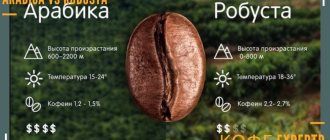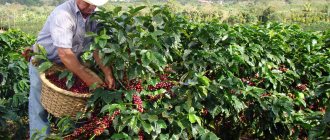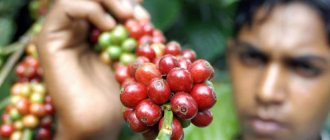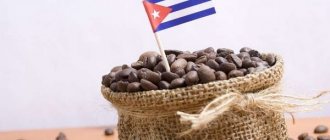Until the end of the 19th century, people in Europe and Asia drank coffee exclusively from Arabica beans. But in 1860, in Uganda, near Lake Victoria, another type of coffee was discovered, which was called robusta for its unpretentiousness and resistance to disease: robusta means “strong” in English.
The botanical name of Robusta is Coffea canephora, or Congolese coffee. It turned out that the indigenous people of Congo and Uganda have been strengthening their strength with coffee beans of this type for a long time.
How does Robusta differ from Arabica?
Robusta is considered the second most popular coffee variety after Arabica. The taste characteristics of these varieties are different. Arabica has a delicate and mild taste, while Robusta, on the contrary, has a rough and pungent taste. The consistency of Robusta is usually transparent. Arabica gives the drink only a slight sourness, while robusta makes it bitter and quite strong. This variety contains approximately 2% caffeine. An excellent option for getting rid of excessive bitterness in coffee is to dilute it with Arabica beans.
Few people know, but everyone’s favorite instant coffee is made from robusta. Through repeated processing, the taste of coffee is significantly softened. But for the most part, the love for this coffee comes not from the taste at all, but from the invigorating effect of caffeine.
Fine Robusta and its potential
It is important to understand that canephora is fundamentally different from Arabica, and each variety is unique in its own way. The correct degree of roasting in this case is extremely important. If you violate the technology, the bitterness will overwhelm the taste of the cup, and the body will be too heavy.
You should not expect the same taste from Robusta as from Arabica. She must be allowed to reveal her natural potential, her individuality, expressed in a pleasant bitterness.
By 2050, climate change is predicted to reduce the area of land available for Arabica production by 50%. This is already pushing farmers to seek higher terrain to maintain the ability to grow specialty Arabica beans.
Robusta can grow at low altitudes, produce a defect-free cup and a varied flavor profile. If the ability to produce Arabica beans diminishes in the near future, Robusta may be the solution. On the part of farmers - to avoid large losses of profit, on the part of consumers - to receive high-quality coffee and a new taste experience.
How to choose Robusta coffee
Due to the low content of sugars and aromatic substances, beans of this type are roasted unevenly.
First of all, you should pay attention to the degree of roasting of the beans. They are usually divided into five groups:
- Scandinavian. With this roasting, the coffee turns out to be more delicate and the color of the beans is lighter.
- American. This roast is considered medium and imparts bitterness to the beans. The grains become bright brown.
- Viennese. This roasting gives the drink a sweeter taste.
- French. This roasting is quite strong, so the grains take on a chocolate color and the taste becomes bitter.
- Italian. The strongest roast, distinguished by the blackness of the beans, is considered a classic option for bitter coffee.
Next, you should pay attention to the processing of the coffee, that is, whether it is ground or beans. Undoubtedly, it is better to give preference to the second option, because in this way the coffee will not lose its aroma.
The cost of good coffee
One of the advantages of Robusta is its affordable price, although finding such coffee on sale in its pure form is not an easy task. However, for true connoisseurs of the drink, scarcity and cost are not a problem.
Here are a few brands that are loved in our country and are widely available on sale:
- Robusta (Uganda) 100 g - 112 rubles;
- Kaapi (India) 100 g - 120 rubles;
- Typica (Vietnam) 100 g - 200 rubles;
- Santos (Brazil) 150 g - 200 rubles;
- Blue Dragon (Vietnam) 150 g - 230 rubles;
- Me Trang (Vietnam) 500 g - 450 rub.
Packaged in 1000 g, the cost of 1 kg of this coffee does not exceed 1000 rubles.
- Noir (Netherlands) 1 kg - 750 RUR;
- Lavazza Gusto Forte (Italy) 1 kg - 790 RUR;
- Lavazza Espresso Vending Gusto Forte (Italy) 1 kg - 800 RUR;
- Bourbon Intenso (Italy) 1 kg - 900 rub.
Methods for preparing Robusta coffee
This type of coffee can be brewed in several ways. Simple but interesting are the following.
Coffee "Oflameron"
Grind the coffee and add a teaspoon to 60 grams of water. The water should be warm. Next, everything is heated over low heat, and when foam forms, a couple of spoons of champagne are added to the coffee (the gas is released first). When excessive foaming begins, remove the coffee from the heat.
Coffee Glace
To prepare this drink you will need coffee, ice cream, whipped cream, and syrup. To begin with, coffee is prepared in a Turk or in a coffee machine. An alternative could be a fench press. The cream is cooled in the refrigerator and whipped, syrup and sugar are added as desired. Ice cream is placed in special containers and filled with syrup. Later, coffee is added and whipped cream is placed on top.
The strongest coffee in the world
Robusta coffee beans grow on shrubs called Coffea canephora . If you do not limit the growth of the plant, it can grow from 2 to 10 meters in height. Congolese coffee is very unpretentious and grows mainly on the plains, where it is impossible to obtain an Arabica crop. He is not afraid of high temperatures, he tolerates heat well up to +30°C.
Translated from Latin, robusta means “strong”. This name was given to it for a reason, because the main genetic feature of this species is considered to be high resistance to various diseases. Coffee bushes produce 10 to 15 harvests per year, making their cultivation very profitable.
Please note that in the word robusta the accent is placed on the letter “y”.
History of origin of the variety
Robusta was first grown in Africa, namely in the Congo. Today, the number of countries where this plant is grown has expanded significantly, but these are mainly countries in Africa and Asia. This variety of coffee was first noticed due to leaf rust, which destroyed Arabica plantations in Sri Lanka. Robusta has shown resistance to diseases and climatic conditions, which led to its further worldwide recognition. The first plantation was on the island of Java, where the variety was introduced in the 20th century. Basically, flat areas are suitable for Robusta; temperature fluctuations and climatic conditions do not affect the harvest.
Robusta's second appearance on the world stage
Due to its low cost, Robusta coffee is too tasty a morsel for businessmen not to find a use for it. While wealthy coffee lovers from all countries swore their love for Arabica, enterprising Italians experimented with mixing it with Robusta.
Recently, one of the senior managers of the Italian company Caffe Molinari admitted that robusta had been added to their famous blends since the beginning of the 20th century. It was only in 2005 that the company released 100% Arabica coffee for the first time.
In addition to the price, Robusta has another undeniable advantage: high, stable foam in espresso coffee. Italian baristas have discovered that adding 10-15% robusta to the mixture makes the espresso stronger and gives it chocolate notes.
The Second World War led to the impoverishment of all of Europe. When there is not enough for bread, there is no time for quality coffee. But people couldn’t give up their favorite drink completely. Each nation found its own solution to the problem.
Robusta plantation in Congo, trees up to 2 meters high to make it easier to pick berries
The Germans, tired of ersatz barley coffee, no longer wanted to buy ground beans: it was too easy to add roasted barley or chicory to them. The population of Germany did not have money for Arabica, and here cheap and strong Robusta could not have come at a more opportune time.
The Italians, even in poverty, continued to embrace aesthetics. Famous companies on the verge of bankruptcy experimented with ground coffee. Various additives were used to give the drink strength; robusta was used.
France at that time still owned colonies in West Africa. The climatic conditions there were more favorable for Robusta than for Arabica. Incentivizing its own producers, the government imposed significant taxes on Arabica imports. The impoverished population was forced to buy cheaper robusta.
The popularity of robusta in the United States increased when a frost hit Brazil in 1954, destroying a significant part of the Arabica plantations. In order not to raise prices too much, large companies (for example, Maxwell House) began to produce Arabica and Robusta blends.
Where does it grow today?
Today, Robusta grows in countries where different techniques are used, so the taste characteristics of coffee may differ. The most common plantations are:
- Plantations in Guatemala. Here Arabica and Robusta are planted together. To increase the yield, plantation owners use the root system from Robusta and make a small cut on the stem. Arabica is grafted there. The coffee from this plantation has a mild flavor typical of Arabica, but at the same time may have the bitterness of Robusta.
- Plantations in Liberia. The trees on these plantations grow tall due to the fertile soils and favorable climatic conditions. The grains take a long time to ripen, but have their own distinctive, tart and rich aroma. Coffee from Liberian plantations can be distinguished by its smell. The drink made from beans collected on such a plantation will be strong and rich in caffeine.
Coffee plantation in Tanzania - Plantations in Tanzania. The grains came here from nearby Kenya. Despite the fact that after the arrival of the colonialists, most of the plantations began to be occupied by Arabica, Robusta continues to grow actively and produce good harvests. The distinctive features of coffee collected from these plantations are its deep taste with slight sourness and berry aroma.
- Plantations in Angola. Back in the 1970s, Angola ranked 4th in coffee production. Later, the war caused damage to all spheres of the country’s life, including the economic one. Now the government is rapidly restoring the situation and continuing development in coffee growing. It is on the plantations of Angola that Robusta has a tart smell and a large amount of caffeine in the beans. The drink made from them acquires a rich chocolate hue and has a slightly sour taste inherent in classic Robusta.
Producing countries of Robusta
Today, Robusta accounts for 25–30% of the total global coffee market. Most of all it is grown not in Brazil, but in Vietnam. The first plantations were founded here by the French in the mid-19th century. However, until the 70s of the 20th century, the volumes of coffee grown here barely covered the country's needs.
Over the next 20 years, the area of plantations increased tenfold. Already in 1990, Vietnam produced 68,000 tons of robusta and ranked 13th among the world's coffee exporters. Nowadays, Vietnamese coffee accounts for 17% of the world market, the country is in second place in the export of beans. 506,000 hectares are allocated for coffee plantations, of which 90% are for robusta.
Other major exporters include India, Indonesia, Ecuador, Madagascar, Cote d'Ivoire, and Tanzania.
Chemical composition of Robusta beans
Classic Robusta contains primarily caffeine, amino acids, various minerals, vitamins, sucrose, aromatic oils, fiber and organic acids. The main difference between Robusta and Arabica is its tart and bitter taste, caused by a large amount of caffeine. Growing Robusta is much easier than Arabica. The first is unpretentious to weather conditions and allows temperature changes, frequent precipitation, and also does not require additional care, such as fertilizers. The yield of Robusta is much higher than that of Arabica.
Varieties and hybrids
The taste of robusta in its pure form is so specific that few people dare to drink it without preparation and habit. However, when mixed with Arabica, you get that same divine taste. Breeders all over the world are trying hard to develop new and unique varieties, both pure and hybrid. However, there are people who prefer to drink Congolese bitter “nectar” without additives.
- One of the best varieties is considered to be Java Katakan from Indonesia. Classified as a specialty, its velvety, dense bouquet includes light sourness, notes of licorice, malt, nuts and earth.
- Ambry is a rich robusta originally from Angola with sweet and earthy notes.
- Conillon (Brazil) - dense, aromatic, strong coffee with an aftertaste of nuts, earth and licorice.
- Bali Shinzan is an Indian variety with unusual spicy-sweet notes of persimmon, Jamaican pepper and cloves.
- Catura (Brazil) is a highland hybrid coffee with notes of citrus.
- Typica is a very rare and therefore expensive variety of coffee from Ethiopia and Latin America.
- Bourbon Santos is a Brazilian robusta obtained from trees of an exceptionally young harvest - up to 3 years.
- Plantation A is another Indian variety with bitterness, spice aroma and chocolate flavor.
- Caracas is a coffee from Venezuela with a rich, dense taste and aroma.
- Java Ineak is a tart, bitter Indonesian variety with a subtle chocolate flavor.
- Quilu is a Congolese variety with the highest caffeine content.
- Vietnamese varieties of Robusta are the mildest. Blue Dragon will surprise you with pistachio notes, a hint of cocoa and toasted bread. Sang Tao 1 - with a chocolate flavor and pleasant tartness.
Hybrids have also won their place in the sun and in the hearts of coffee lovers:
- Maragogype is a very popular variety, characterized by an unusually bright taste of nuts, cream or chocolate. The beans of this variety are very large, hence the name - elephant beans. The variety is low-yielding and therefore not cheap; it originated in the 19th century in the Brazilian province of Bahia.
- Mundo Novo is a hybrid of Arabica Bourbon and Typica, bred in Brazil in the 80s of the last century.
- Hybrido de Timor is a hybrid of Arabica and Robusta from the island of Timor.
Benefit for health
Coffee in small doses, that is, about one cup a day, is beneficial for the body. After all, this drink contains not only caffeine, but also a lot of useful acids and vitamins, which in turn are a preventive measure against some terrible diseases, such as:
- cancer
- diabetes (both insulin-dependent and non-insulin-dependent)
- asthma
- cirrhosis of the liver
- various reproductive diseases
The distinctive beneficial properties of Robusta lie in its strength. Caffeine here is from 2%, coupled with beneficial biological acids, the drink has strong antioxidant properties. Also, a drink from Robusta tones up twice as much as from Arabica.
The difference between high-quality and low-quality robusta
Leaf rust continues to destroy huge Arabica plantations. Plantations in Brazil suffered in 2008, and in Honduras in 2022. Global warming is also making itself felt. Scientists predict that if the climate changes at the same rate as now, by the middle of the 21st century, a significant part of Arabica plantings will die. Therefore, Robusta will become the main type of coffee on the planet.
Barista's complaints about Robusta are well known: rough, unpleasant taste, insufficiently intense aroma, excessive strength. An ardent opponent of this type of coffee was Ernesto Illi, who in the mid-20th century headed ILLY, one of the most famous bean roasting companies.
Oddly enough, despite the ire of many famous baristas, Robusta sales are only increasing. Moreover, they not only make instant coffee from it, but also add it to mixtures, even such well-known ones as Lavazza.
In fact, most of the qualities of Robusta for which coffee lovers do not like it are explained by the conditions of growing and drying the beans. Low cost has played a cruel joke on this type of coffee: it is grown in the poorest regions of the world and does not pay due attention to the quality of processing.
Farmers do not particularly value robusta plantings: they bring less profit than Arabica plantations. So, when the global coffee overproduction crisis broke out in 2001, Ecuador uprooted most of its robusta trees and replaced them with cocoa.
Roasted Robusta beans
The low quality of some varieties of Vietnamese coffee is explained by the fact that almost 90% of the beans in the country are grown by small farmers who own plots of 1–5 hectares. They often harvest robusta in one go, picking both ripe and unripe berries. The government is raising awareness and the quality is improving, albeit slowly.
Another problem of poor countries is poor processing. Farmers cannot afford to purchase expensive equipment. Coffee berries are laid out to dry on plank platforms or on mats that are not fresh. As a result, the grains acquire the smells of earth and grass, which is what Indonesian Robusta is especially famous for.
Quality standards for Robusta also leave much to be desired: 450 defective grains are allowed per 300 g, which is 10 times more than for Arabica. In such conditions it is simply impossible to get good coffee.
Well-known world manufacturers who add robusta to their mixtures buy Vietnamese and Indonesian grains processed by the wet method. This coffee costs almost the same as Arabica.
Harm to health
Excessive consumption of coffee can lead to the following consequences:
- attachment begins to form, and later dependence on this product
- heart function is somewhat impaired
- the nervous system is excited
- various microelements are washed out of the body
Due to the fact that Robusta has a strong strength, it is contraindicated to drink for people with problems with the cardiovascular system, high blood pressure, glaucoma, and also during pregnancy.
Types of Robusta coffee
Due to the fact that this variety is highly popular, many varieties of coffee have been developed, which contain a large percentage of robusta.
- Robusta "Uganda" - has a strong aroma. Uganda is ideal for making espresso.
- “Cameroon” has a tart aroma with a delicate caramel flavor.
- "India Parchment" - gives the taste of the infusion with a pronounced aroma of dark chocolate.
- “Vietnam” - this type of coffee has the highest caffeine content, therefore its taste is very strong with a slight bitterness.
How to Store Robusta Beans to Preserve Flavor
Coffee beans are the most favorite storage option for coffee among connoisseurs. After grinding, it acquires a unique smell and taste. But it is worth noting that improper storage of such coffee can lead to a significant reduction in its shelf life. The grains perfectly absorb foreign odors.
That is why it is best to store them in an airtight container, preferably so that light does not penetrate there. The shelf life of coffee beans varies depending on the packaging. If everything was done correctly, the grains will be suitable for about a year. If the packaging was done incorrectly, the period will be significantly reduced.
Roasting
Roasting 100% Robusta is a whole technique. There are several types of roasting, on which the taste and aroma depend:
- Light roast. This roasting is done in order to obtain the most neutral taste without any bitterness.
- Medium roast. There is a slight bitterness in the taste, but the taste becomes richer and more aromatic.
- Maximum roast. This roasting is done for lovers of a very strong drink, and considering that Robusta is already considered a very strong variety, lovers of regular coffee should not roast this variety in this way. Because it will turn out very strong.
What is Arabica
The Arabian coffee tree, from which the popular Arabica beans are obtained, began to be cultivated on an industrial scale in the 14th century in Ethiopia. But wild trees still grow here. It's not even really a tree, but a shrub.
When free, this bush can reach up to 6 meters, but it is pruned to 2 meters to make it more convenient to pick berries.
Bush-trees of this variety are beautiful, but they require constant care. They require constant attention and adherence to temperature conditions. Plantations are usually located in the mountains at an altitude of 2000 meters. Read more about this type of coffee in the article “What is Arabica coffee.”
Interesting! Recipes for making raf coffee, composition of the drink and various additives
Robusta coffee tree
Robusta coffee beans do not grow on a tree, but on a bush, but a very unusual one and very tall. In its natural environment, an evergreen bush can grow up to 10 meters in the air. Harvesting at such a height is inconvenient, so in coffee plantations the plants are cultivated and pruned.
The root system of the shrub is superficial. Its bulk is concentrated in the upper 15-centimeter layer of soil, which does not allow the extraction of moisture from the lower layers of the earth.
The coffee bush begins to bear fruit around the third year of life. The plant belongs to the remontant species, that is, it bears fruit all year round.
Growing: temperature and soil
To obtain a sustainable and high-quality harvest, it is necessary to take into account the characteristics of evergreen shrubs. Proper growth, timely flowering and good fruiting are achieved by optimal temperature and special soil composition.
Robusta is a relatively not picky plant. It is more tolerant of temperature changes and can withstand even relatively high temperatures. But the ideal temperature for fruit growth and ripening is in the range from 22 to 25°C.
As for the soil, it should be loose and fertilized with organic matter. Coffee bushes need nitrogen and potassium fertilizers. The soil should be moderately moist.
Recommendations for selection
When choosing Robusta, you should pay attention to the following nuances:
- Manufacturer. The lion's share of this type of coffee beans comes from Vietnam, but the best varieties grow in Brazil, Angola and Congo.
- Appearance. The fruits should be the same size, evenly fried, without coffee crumbs.
- Roasting degree. It is better to choose a medium degree of roasting, it does not aggravate the already bright bitterness.
When properly prepared, Robusta can surprise any gourmet with its taste. In combination with Arabica, this variety will bring an incredible combination of astringency, strength and thick foam into the life of a coffee lover.
Photo by Susanne Jutzeler from Pexels
What affects quality
Arabica plantations still suffer from leaf rust, and farmers have to become more sophisticated. They cultivate Robusta using different technologies to achieve the best taste.
Baristas are against this variety. They believe that it does not have such harmonious taste qualities as Arabica. In fact, everything is not so bad. The quality of robusta depends on the climate and conditions under which the coffee was grown.
Interesting! Various popular types of coffee, their descriptions and methods of preparation in coffee shops
In poor countries like India and Indonesia, coffee is grown without meeting all technological requirements. Coffee trees are poorly cared for. And they can dry grains on old mats or wooden platforms, which are almost never washed. The grains absorb the smell of grass and earth. This spoils the taste of the coffee.
In Vietnam, robusta is grown by small farmers who harvest the entire crop at once, including unripe grains. This leads to a large number of defects and deterioration in quality. Today this problem is being solved at the state level.
To obtain an acceptable taste of the coffee blend, manufacturers prefer wet-processed Robusta. It allows you to get rid of the unpleasant smell of dried grains.











